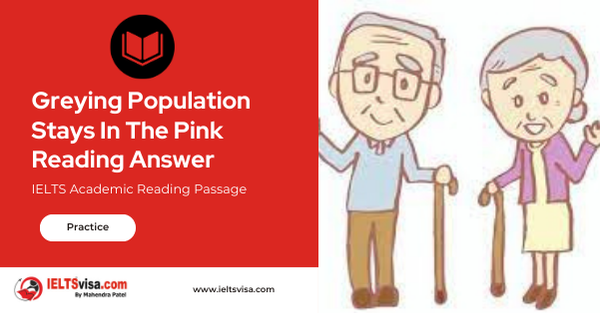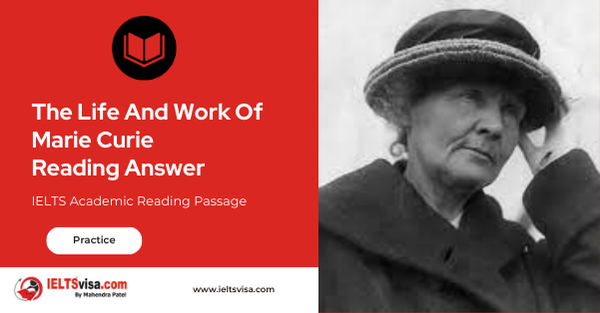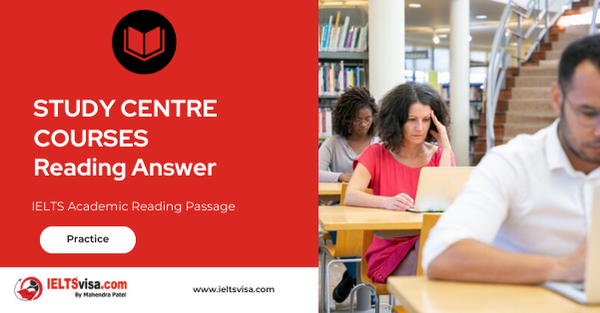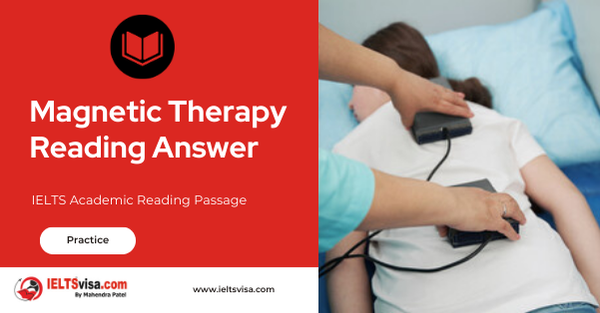Greying Population Stays In The Pink Reading Answer
IELTS Academic Reading Passage
Elderly people are growing healthier, happier and more independent, say American scientists. The results of a 14-year study to be announced later this month reveal that the diseases associated with old age are afflicting fewer and fewer people and when they do strike, it is much later in life.
In the last 14 years, the National Long-term Health Care Survey has gathered data on the health and lifestyles of more than 20,000 men and women over 65. Researchers, now analysing the results of data gathered in 1994, say arthritis, high blood pressure and circulation problems – the major medical complaints in this age group – are troubling a smaller proportion every year. And the data confirms that the rate at which these diseases are declining continues to accelerate. Other diseases of old age – dementia, stroke, arteriosclerosis and emphysema – are also troubling fewer and fewer people.
‘It really raises the question of what should be considered normal ageing,’ says Kenneth Manton, a demographer from Duke University in North Carolina. He says the problems doctors accepted as normal in a 65-year-old in 1982 are often not appearing until people are 70 or 75.
Clearly, certain diseases are beating a retreat in the face of medical advances. But there may be other contributing factors. Improvements in childhood nutrition in the first quarter of the twentieth century, for example, gave today’s elderly people a better start in life than their predecessors.
On the downside, the data also reveals failures in public health that have caused surges in some illnesses. An increase in some cancers and bronchitis may reflect changing smoking habits and poorer air quality, say the researchers. ‘These may be subtle influences,’ says Manton, ‘but our subjects have been exposed to worse and worse pollution for over 60 years. It’s not surprising we see some effect.’
One interesting correlation Manton uncovered is that better-educated people are likely to live longer. For example, 65-year-old women with fewer than eight years of schooling are expected, on average, to live to 82. Those who continued their education live an extra seven years. Although some of this can be attributed to a higher income, Manton believes it is mainly because educated people seek more medical attention.
The survey also assessed how independent people over 65 were, and again found a striking trend. Almost 80% of those in the 1994 survey could complete everyday activities ranging from eating and dressing unaided to complex tasks such as cooking and managing their finances. That represents a significant drop in the number of disabled old people in the population. If the trends apparent in the United States 14 years ago had continued,
researchers calculate there would be an additional one million disabled elderly people in today’s population. According to Manton, slowing the trend has saved the United States government’s Medicare system more than $200 billion, suggesting that the greying of America’s population may prove less of a financial burden than expected.
The increasing self-reliance of many elderly people is probably linked to a massive increase in the use of simple home medical aids. For instance, the use of raised toilet seats has more than doubled since the start of the study, and the use of bath seats has grown by more than 50%. These developments also bring some health benefits, according to a report from the MacArthur Foundation’s research group on successful ageing. The group found that those elderly people who were able to retain a sense of independence were more likely to stay healthy in old age.
Maintaining a level of daily physical activity may help mental functioning, says Carl Cotman, a neuroscientist at the University of California at Irvine. He found that rats that exercise on a treadmill have raised levels of brain-derived neurotrophic factor coursing through their brains. Cotman believes this hormone, which keeps neurons functioning, may prevent the brains of active humans from deteriorating.
As part of the same study, Teresa Seeman, a social epidemiologist at the University of Southern California in Los Angeles, found a connection between self-esteem and stress in people over 70. In laboratory simulations of challenging activities such as driving, those who felt in control of their lives pumped out lower levels of stress hormones such as cortisol. Chronically high levels of these hormones have been linked to heart disease.
But independence can have drawbacks. Seeman found that elderly people who felt emotionally isolated maintained higher levels of stress hormones even when asleep. The research suggests that older people fare best when they feel independent but know they can get help when they need it.
‘Like much research into ageing, these results support common sense,’ says Seeman. They also show that we may be underestimating the impact of these simple factors. ‘The sort of thing that your grandmother always told you turns out to be right on target,’ she says.
Questions 1-9
Complete the summary using the list of words, A-Q, below. Write the correct letter, A-Q, in boxes 1-9 on your answer sheet.
Research carried out by scientists in the United States has shown that the proportion of people over 65 suffering from the most common age-related medical problems is 1………………… and that the speed of this change is 2………………….
It also seems that these diseases are affecting people 3…………………. in life than they did in the past.
This is largely due to developments in 4…………………. but other factors such as improved 5…………………. may also be playing a part.
Increases in some other illnesses may be due to changes in personal habits and to 6………………….
The research establishes a link between levels of 7…………………. and life expectancy.
It also shows that there has been a considerable reduction in the number of elderly people who are 8………………… which means that the 9…………………. involved in supporting this section of the population may be less than previously predicted.
Questions 10-13
Complete each sentence with the correct ending, A-H, below. Write the correct letter, A-H, in boxes 10-13 on your answer sheet.
10.Home medical aids 10…………………
11.Regular amounts of exercise 11…………………
12.Feelings of control over life 12…………………
13.Feelings of loneliness 13…………………

Solution for: Greying Population Stays In The Pink Reading Answer
| 1. B | 8. G |
| 2. I | 9. A |
| 3. F | 10. G |
| 4. M | 11. E |
| 5. J | 12. H |
| 6. N | 13. C |
| 7. K |
Review and Practice
- Regularly practice with IELTS reading samples and time yourself to get used to the pressure of the exam.
- Review your mistakes to understand where you went wrong and how to avoid similar errors in the future.
Our Books
Master IELTS Speaking Part 1
IELTS Writing Task 1 Book
IELTS Writing Task 2 Book
Greying Population Stays In The Pink Reading Answer Explanation
Comin Soon
Practice IELTS Other Modules
IELTS Listening
The IELTS Listening test assesses how well you can understand spoken English in various contexts. It lasts about 30 minutes and is divided into four sections with a total of 40 questions. The listening tasks become increasingly difficult as the test progresses.
IELTS Academic Reading
The IELTS Academic Reading section assesses your ability to understand and interpret a variety of texts in academic settings. It is designed to evaluate a range of reading skills, including skimming for gist, reading for main ideas, reading for detail, understanding inferences, and recognizing a writer's opinions and arguments.
IELTS Speaking
The IELTS Speaking test assesses your ability to communicate in English on everyday topics. It lasts 11-14 minutes and consists of three parts: introduction, cue card, and a discussion based on the cue card topic.
IELTS General Reading
IELTS General Reading tests your ability to understand and interpret various types of texts. Here are some key areas and types of content you can expect to encounter in the reading section, along with tips for effective preparation.
IELTS Academic Writing Task 1
In IELTS Academic Writing Task 1, you are presented with a visual representation of information, such as graphs, charts, tables, or diagrams, and you are required to summarize, compare, or explain the data in your own words.
IELTS General Writing Task 1
In IELTS General Writing Task 1, you are required to write a letter based on a given situation. The letter can be formal, semi-formal, or informal, depending on the prompt. Here’s a breakdown of the key components to include in your letter
IELTS Academic Writing Task 2
In IELTS Academic Writing Task 2, you are required to write an essay in response to a question or topic. Here’s a guide to help you understand the essential elements of this task
IELTS Exam Tips
To succeed in the IELTS exam, practice regularly, familiarize yourself with the test format, improve your vocabulary, develop time management skills, and take mock tests to build confidence.
Grammer for IELTS
Grammar is the foundation of effective communication in English. Understanding tense usage, subject-verb agreement, and sentence structure enhances clarity and coherence in writing and speaking.
Vocabulary for IELTS
Vocabulary plays a crucial role in the IELTS (International English Language Testing System) exam, especially in the Speaking and Writing sections. Here’s an overview of why vocabulary is important and how it impacts your performance
RECENT IELTS SAMPLES QUESTIONS AND ANSWERS
The Life And work Of Marie Curie Reading Answer
Marie Curie is probably the most famous woman scientist who has ever lived. Born Maria...
Becoming An Expert Reading Answer
A Expertise is commitment coupled with creativity. Specifically, it is the commitment of...
STUDY CENTRE COURSES Reading Answer
SELF-STUDY TIPS AHowever difficult you find it to arrange your time, it will pay off in the...
The Extrinct Grass In Britain Reading Answer
A The British grass interrupted brome was said to be extinct, just like the Dodo. Called...
Morse Code Reading Answer
A. A new satellite-based system is being implemented to replace Morse code for sending...
Magnetic Therapy Reading Answer
AMagnetic therapy, which is a $5-billion market worldwide, is a form of alternative medicine...













